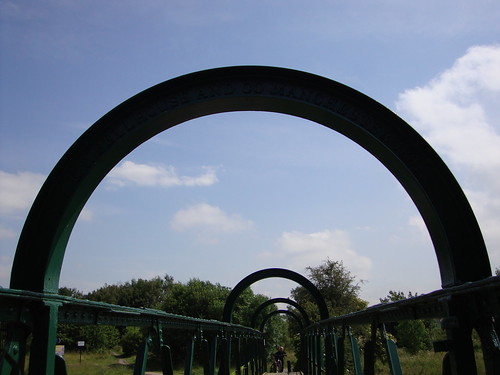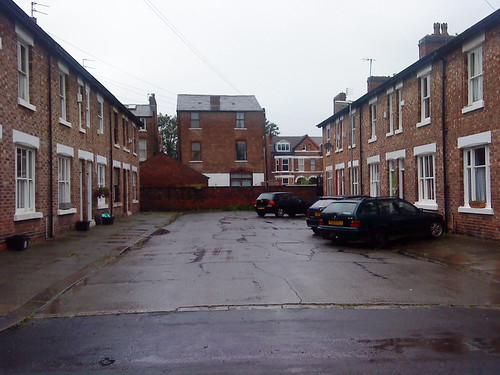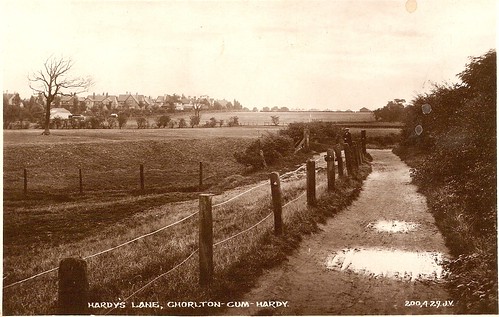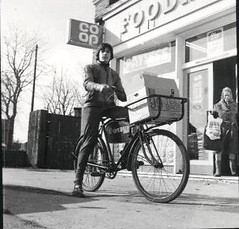Situated in a suburb of Manchester, England this is a story of a co-op store still with meeting rooms above the shop, and the lane itself. Plus other related or not so related history.
Tuesday, June 30, 2009
Co-op Candidates 1934
"We are particularly proud of the fact that Barlow Moor Guild has put up a candidate for its own ward, and we have a whole-hearted enthusiasm amongst all the members of the Guild that should go a long way in attaining the result we are aiming for, that for the first time in municipal history the Didsbury Ward will be represented on the City Council by a democratic candidate, who is also of the M&S Co-op Party and a Guild worker."
Barlow Moor Guild Report in the Manchester & Salford Co-operative Herald October 1934
An optimistic outlook for an election contest in a safe Tory seat. There were two other candidates nominated by the Co-op Party - Mrs. Clara Bamber in Chorlton; and Mr. William Taylor (then Secretary of Withington Constituency Labour Party) in St. Luke's ward. A grant of £3 3s. (£3.15) was made to the Manchester Labour Party towards the expenses of a poster campaign. Also the Directors of the Co-op Society designated three cars to be placed at the disposal of the three candidates to be available from noon on polling day.
M&S Co-op Party Report in the Manchester & Salford Co-operative Herald December 1934.
Thursday 1st November 1934 - Manchester Municipal Elections
Didsbury ward
S.P.Dawson (C) 3027
W.Ingham (Lab) 1355
An unsuprising result against the sitting Conservative, Councillor Lt-Col S.P.Dawson MM who was first elected for Didsbury in 1928. As of yet I've been unable to find a picture of Mr.Ingham, his name crops up a number of times in Labour and Co-operative reports in this period.
The other results were :
Chorlton ward -
W.Somerville (C) 4,580
Clara Bamber (Lab) 1,664
St. Luke's
T.R.Ackroyd (L) 1873
W.Taylor (Lab) 1341
Monday, June 29, 2009
Hardy Lane 100 years ago
 Taken from Slater's Street Directory of Manchester & Salford published 1909. As you will observe - no house numbers, two farmers (Hardy Farm with James Brundrett, and Hardy House Farm with James Richardson), a pub (that's at Jackson's Boat). A cricket club founded in 1885 - the ground is still there but the cricket stopped a few years ago. Chorlton Golf Club carries on but the club house moved down the road to Barlow Hall at sometime in the 20th Century. Everybody else resides in a a block of cottages called Hardy Cottages or The Block House.
Taken from Slater's Street Directory of Manchester & Salford published 1909. As you will observe - no house numbers, two farmers (Hardy Farm with James Brundrett, and Hardy House Farm with James Richardson), a pub (that's at Jackson's Boat). A cricket club founded in 1885 - the ground is still there but the cricket stopped a few years ago. Chorlton Golf Club carries on but the club house moved down the road to Barlow Hall at sometime in the 20th Century. Everybody else resides in a a block of cottages called Hardy Cottages or The Block House.
Saturday, June 27, 2009
Bridge at the end of the Lane

Hardy Lane is a no through road for traffic but it carries on as a footpath to Jackson's Boat. It deviates from its original course in places. At the end is an iron footbridge over the River Mersey to the pub and Rifle Road.
The bridge was opened on Friday 14th October 1881 and you had to pay a toll to cross it until sometime in the 1940's. The name of the iron manufacturer was E.T. Bellhouse who had the Eagle Foundry off Oxford Street in Manchester. I only recently found out that this was no ordinary foundry but a remarkable one. Edward Taylor Bellhouse (b. 1816) was the leading manufacturer of iron portable buildings, and did constructions for Balmoral Castle, in Peru, Argentina, Melbourne, some railway bridges, hydraulic presses, the list goes on...
This was one of his last constructions, though the firm carried on until around 1893. E.T. Bellhouse died on Thursday 13th October 1881 - the day before the bridge opened.
Lots of information in Chapter 4 E.T. BELLHOUSE AND CO. ENGINEERS AND IRON FOUNDERS - all 38 pages (PDF)
Thursday, June 25, 2009
Time for Tea
 There is a small kitchen that goes with the meeting rooms, and you know where this leads. Meetings and a cup of tea, possibly a biscuit or two. It would possibly have been Co-op 99 Tea. Always described as an iconic brand, and it has an interesting history.
There is a small kitchen that goes with the meeting rooms, and you know where this leads. Meetings and a cup of tea, possibly a biscuit or two. It would possibly have been Co-op 99 Tea. Always described as an iconic brand, and it has an interesting history."Many inter-war tea advertisements made health claims for their products, Brooke Bond launching their popular 'Digestive Tea' at 2/6d a pound in 1932, which echoed the claims of Ty-phoo. Brooke Bond was, however, overtaken by the Co-operative Wholesale Society which promoted its 'No.99' blend, implying 'just what the doctor ordered'. In the 1930's the CWS held 30 per cent of the tea market, the largest share of all."
from Liquid pleasures: a social history of drinks in modern Britain by John Burnett - 1999.
 In 1929 when this Co-op store opened Britons were consuming 10 lbs of tea per person in a year. That's 4.55 kilos of mostly loose tea, though tea bags were invented in 1903. The '99' health connection is that doctors in assessing vocal fremitus ask the patient to repeat the phrase 'ninety-nine' whilst placing the palm of the hand on the patient's chest. They probably still do.
In 1929 when this Co-op store opened Britons were consuming 10 lbs of tea per person in a year. That's 4.55 kilos of mostly loose tea, though tea bags were invented in 1903. The '99' health connection is that doctors in assessing vocal fremitus ask the patient to repeat the phrase 'ninety-nine' whilst placing the palm of the hand on the patient's chest. They probably still do.'99 Tea' used to be blended and packaged at a CWS tea and coffee works in Crewe, Cheshire until the 1980's. Don't know where it is assembled now, but it is fairtrade these days.
Sunday, June 21, 2009
Home delivery
Saturday, June 20, 2009
The Buildings Near The River

Still intrigued by the two buildings that were on Hardy Lane, west of Hardy Farm half way to the River Mersey. They also appear on Hennet's Map of Lancashire. This map was surveyed in 1828 and 1829 and published in 1830 by Henry Teesdale to a scale is 7½ ins to 10 miles.
The surveyor was George Hennet, who is very possibly the chap with the same name who became the noted railway engineer. See Wikipedia entry. Need to find out more about the floods in the 1850's when these buildings were destroyed or abandoned and do not appear on later OS Maps of Chorlton-cum-Hardy. See earlier posts with the label 'maps'.
Thursday, June 18, 2009
The Other M&S part 2

In Leeds the other day, it's one of my favourite cities, and we took ourselves up to the University end of town. Into the Parkinson building, and that is some magnificent architecture, opened in 1951 with no expense spared. Inside there is a Marks & Spencer exhibition celebrating their 125 years. There is also a good Marks & Spencer cafe to go with it if you need to rest you legs and get some quality refreshments.
It doesn't take long to get around the displays but there were lots of facts I discovered, especially about the time M&S had their head office in Manchester and the directors lived in Didsbury and up Bury New Road.
There is an online version here though it doesn't come anywhere near seeing the handwriting of Mr. Marks and Mr. Spencer and the artifacts.
The only similarities between the Manchester & Salford Equitable and Marks & Spencer are in the two letters of the alphabet they shared.
Thursday, June 11, 2009
Guild Starts in 1931
The following Tuesday they held a whist drive, which "proved very successful, both socially and financially, and also brought along a number of new members for the guild".
Manchester & Salford Co-operative Herald 1931 page 211
The new guild got off to a good start, and instead of closing for the month of August as would be and still is the norm for voluntary organisations like this they kept holding a Tuesday meeting throughout that month.
Members Group Talk
Wednesday, June 10, 2009
Other Hardy's As Well

There are four Hardy Lane's in England, none on Scotland or Wales. Two are in rural locations. One in Tideswell near Buxton, a pretty village that still has Well Dressing events - a good old Derbyshire custom. Another is in Tockington, near Bristol. The third is in urban Basingstoke. The 4th is this one in Chorlton-cum-Hardy. So not a common name
As you'd expect lots of Hardy Avenues, Roads, Closes, Drives and places associated with the Thomas Hardy the novelist. Above is a photo of Hardy Avenue in Chorlton. Taken today in the rain. A cul-de-sac off Acres Road, which runs between Beech Road and High Lane. The building behind is on St.Clement's Road.
Sunday, June 7, 2009
Aerial View 1933
 A view from 1933 and you can make out the Hardy Lane store as the only buildings at the bottom on the west side of Barlow Moor Road. Chorlton Park School opened in 1928 is in the middle, behind which is the unlaid Chorlton Park with a border of trees.
A view from 1933 and you can make out the Hardy Lane store as the only buildings at the bottom on the west side of Barlow Moor Road. Chorlton Park School opened in 1928 is in the middle, behind which is the unlaid Chorlton Park with a border of trees.Other aerial views show the Barlow Moor Estate still under construction with plenty of empty plots of land. The building work must have gone on for many years, six to ten years maybe, starting at the Cundiff Road end in the north and finishing at Princess Road in the south.
Aerial view Aerial view 2
Saturday, June 6, 2009
Hardy Lane c.1912

I'm guessing it is 1912. But cetainly after Chorltonville was built because that looks like South Drive in the background and the recreation pavilion. There are also some goal posts. That's interesting because I thought it was just tennis and bowling for the residents.
The trick now will be to go the same spot and take the same view a hundred or so years later. If it wasn't raining today the camera and tripod would have been set up already. Maybe I'll have to wait until the trees have lost their leaves too. The result would be something like this.
Friday, June 5, 2009
Other websites
Friends of Chorlton Meadows is one of my regular reads. It's a great read about the fauna and flora of the area. Plus it ties in with the seasons. Hardy Lane runs across the Meadows as a footpath to Jackson's Boat so am taking a keen interest.
Three recent articles from the weblog:
Mersey Floods by a local historian
Metrolink will devastate the Mersey Valley
Great Mersey Valley Revolt
Thursday, June 4, 2009
Sorting Thru It All

When I started this weblog it was to publish information as it came along or dug out of archives. Then lots of scraps of details emerge. It's a bit like getting a few jigsaw pieces but where to fit them in when you don't have the big picture on the box.
Bits include information about the farms on Hardy Lane, who lived at the cottages at the end of the lane, and what the 19th century farm kitchen looked like. Buildings and people now long gone. Then there are details about the Barlow Moor Mixed Guild activities over the years. Nothing as yet on the Woodcraft Folk who still operate from the hall. Still trawling through old photographs of Chorlton, many not that old as they date from the 1980's and 1990's. Still looking for that snap of the store in the red Late Shop livery or the earlier green and yellow Norwest livery.
Above are some pictures of old CWS tins for custard powder and health salts. If you search eBay you come across plenty of co-operative memorabilia, some at unrealistic prices. I recommend all history fans to search about once a week.

